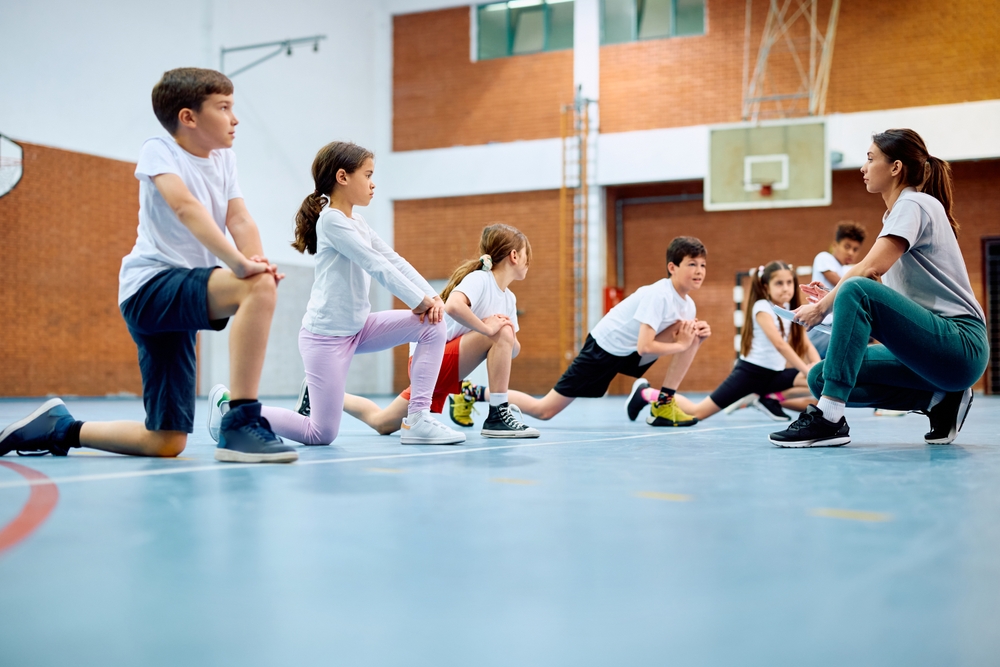Physical Education Jobs — Your Complete Guide
Introduction
Physical education jobs can open many doors. You can teach, coach, train, manage, or lead sports programs. Today in health is made more important than anything else. Schools, clubs, gyms, and communities all need experts in this field.
If you are looking at getting active, motivating others, and shaping healthier lives, this blog will give you a hand. You will learn:
- What types of physical education jobs exist
- What qualifications and skills you need
- How much salary you can expect
- How to find and succeed in these jobs
I will write in simple language, with direct sentences. I avoid consecutive sentences (you won’t see many “and then” in a row). Let’s begin.

What Are Physical Education Jobs?
“Physical education job” covers many roles related to teaching, coaching, fitness, and sport. Essentially, they involve promoting physical activity, sports skills, wellness, and health education.
These jobs can be in:
- Schools (primary, secondary, higher)
- Colleges or universities
- Sports academies
- Fitness centers or gyms
- Community recreation centers
- Private coaching or training services
- Corporate wellness programs
Each role has its own focus. But all share a core goal: help people move better, grow stronger, and lead healthier lives.
Why Choose a Career in Physical Education?
Here are reasons many people pick this path:
- You stay active. It don’t sit in a cubicle all day.
- You make a difference. or help children and adults improve health.
- Also can specialize. You can focus on coaching, training, or sports management.
- Opportunities are growing. The wellness, health education, and fitness sectors are growing.
- Flexible working conditions. One can work in schools, gyms, camps, or even private practice.
Still, there are some challenges preventing this profession from being all roses. In certain areas, pay is a little low or they just want you to have some additional certifications. But if your heart is into sports and teaching, this just might feel like a calling; working in it just becomes secondary.
Types of Physical Education Jobs
Below are common roles in this field. I describe each one and the tasks involved.
- Physical Education (PE) Teacher / Instructor
- Teach students at school.
- Plan lessons, games, fitness drills.
- Organize sports events, assessments.
- Monitor fitness progress.
- Motivate students to stay active.
- Sports Coach / Trainer
- Train athletes in specific sports (football, basketball, etc.).
- Develop skills, strategy, strength.
- Create training schedules.
- Analyze performance and correct technique.
- Fitness Instructor / Personal Trainer
- Work with individuals or small groups.
- Design personalized workout plans.
- Guide clients in gyms or outdoors.
- Track progress, modify plans.
- Athletic Director / Sports Manager
- Oversee sports programs of schools or clubs.
- Manage budgets, logistics, staff.
- Schedule matches, events, tournaments.
- Liaise with external bodies (associations, federations).
- Recreation / Community Sports Coordinator
- Plan and run local sports and activity programs.
- Work in parks, community centers.
- Promote health in local communities.
- Higher Education Faculty / Lecturer
- Teach in colleges or universities.
- Conduct research in sports science, kinesiology, etc.
- Supervise student projects.
- Health & Wellness Coach / Corporate Fitness Specialist
- Work in corporate settings.
- Promote employee health programs.
- Create wellness plans.
- Adaptive Physical Education Specialist
- Work with persons with special needs.
- Modify sports or exercises.
- Ensure inclusive physical activity.
- Sports Scientist / Exercise Physiologist
- Study human movement, biomechanics, physiology.
- Develop evidence-based training programs.
- Work with elite athletes.
- Sports Event Manager
- Organize tournaments, competitions.
- Handle logistics, scheduling, operations.
These roles may overlap. For example, a PE teacher might also coach a school team.
Qualifications & Skills Needed
Other roles require at least certain qualifications. But below is a general list of what employers often look for:
Educational Requirements
- Bachelor in Physical Education, Sports Science, Kinesiology, or the like.
- For the bigger roles (college or research), a Master’s or Doctorate will help.
- In many places, you need a teaching certificate or license.
Certifications & Training
- First-aid and CPR certifications.
- Fitness certifications (e.g., certified personal training credentials).
- Sports-specific certifications (coaching certification).
- Workshops or continuing education programs in health, nutrition, or biomechanics.
Soft Skills
- Communication: explain clearly to students or clients.
- Leadership: guide teams or classes.
- Patience and motivation: help struggling learners.
- Organization: plan schedules, events.
- Adaptability: vary methods for different people.
Technical Skills
- Knowledge of anatomy, physiology, biomechanics.
- Skill in using fitness equipment.
- Ability to assess fitness, measure performance.
- Use of digital tools or apps for tracking progress.
Experience
Internships, volunteering, or assistant roles help. Many schools and organizations prefer candidates who have coached or taught earlier, even at lower levels.
Salary & Job Market
Let us look at what pay you might expect and where demand is growing.
Salary — Global & India
- In the United States, the average salary for a physical education teacher is about $74,228 per year (Indeed data)
- The U.S., rates vary by state, role (elementary, high school) and experience.
- In India, a PE teacher’s average monthly salary is ₹20,317 (Indeed)
- It is suggested that some might have monthly rates of ₹25,000 or even ₹29,000.
Starting PE teachers in India could be earning between ₹15,000 and ₹25,000 per month, depending on whether they are working with government bodies or any of these private schools; then experienced ones might be skilled to earn more, especially in a good private or international school set-up.
Job Market & Demand
- Many schools always need PE teachers.
- Fitness and wellness industries are booming.
- Community recreation programs are expanding.
- Higher education and sports research also offer opportunities.
- Some regions, especially rural or low-resource areas, suffer from a shortage of trained PE teachers.
For example, in some districts, committees have flagged severe shortages of PE teachers in rural schools.
Thus, while competition exists in certain markets, demand is solid in many places.
How to Find Physical Education Jobs
Here is a step-by-step guide to help you land a role.
- Prepare a strong resume / CV
- Conversation with a mentor or senior professional helps the same way.
- “I did a 20% endurance improvement in 50 students whom I coached.”
- Add measurable results: “Led 50 students in a fitness program, improving their endurance by 20%.”
- Add measurable results: “Led 50 students in a fitness program, improving their endurance by 20%.”
- Include references.
- Build a portfolio / sample lessons
- Create sample lesson plans.
- Show video clips or photos of you coaching or teaching.
- Show student success stories or improvements.
- Certifications & continuing education
- Pursue recognized fitness or coaching certifications.
- Attend workshops or seminars.
- Network & volunteer
- Join sports clubs, community programs.
- Volunteer to coach.
- Attend education fairs.
- Search smartly
- Use teaching job portals, school websites.
- Use specialized PE/sports job boards.
- Leverage social media and professional networks.
- Tailor your applications
- Customize cover letters for each school or organization.
- Highlight how you fit their specific needs.
- Prepare for interviews
- Be ready to teach a mock lesson.
- Answer questions about discipline, safety, inclusion.
- Show you can adapt to different ages or abilities.
- Start with entry-level roles
- Try assistant coach, substitute PE teacher, or part-time roles.
- Use them to gain experience.
- Stay updated
- Trends in fitness, sports science, health education change.
- Keep learning new methods.
Challenges & How to Overcome Them
Every career has hurdles. Here are ones you may face and tips to deal with them.
| Challenge | Possible Solution |
| Low pay in some regions | Aim for private schools or international schools, freelance roles, or coaching side gigs. |
| Heavy workload or event demands | Use time management; delegate where possible; balance duties. |
| Recruiting students’ interest | Use varied and fun activities; link to real-life benefits. |
| Safety or injury risks | Obtain proper training; design safe activities; use first aid kits. |
| Certification cost | Seek grants or subsidized training; start with lower-cost certifications. |
Tips to Succeed & Grow
- Always show passion. Students and employers sense enthusiasm.
- Be adaptable. Each batch of students is different.
- Use feedback. Analyze with students what they liked and disliked, and then make changes.
- Check the fitness of your methods, and if new approaches are being developed, do update accordingly.
- Create professional networks. Join associations in your region.
- Occupy governance roles; take a department head or coach coordinator role.
- Small articles for journals or blogging might help create your profile.
- Further your study or specialization (perhaps sports science, neuroscience).
Sample Lesson Planning & Class Ideas
Here are a few sample class ideas and planning tips you can use:
- Warm-Up / Stretching (10 min)
- Dynamic movements: leg swings, arm circles.
- Light jogging or skipping.
- Skill Practice (15 min)
- Drills for a specific sport (dribbling, passing).
- Focus on technique, repetition.
- Fitness / Strength Circuit (10 min)
- Rotating stations: push-ups, squats, plank.
- Use bodyweight or light gear.
- Small Game / Activity (10 min)
- Mini-match, relay, tag.
- Encourage healthy competition.
- Cool Down / Reflection (5 min)
- Stretching, breathing.
- Ask students what they learned or liked.
When planning, vary the intensity, rotate sports, and ensure inclusive participation.
Case Example: PE Teacher in India
Let us illustrate with an example likely familiar in India.
Ravi just completed his B.P.Ed degree. He applies to a school under the CBSE stream located in his city. and lists volunteer-based coaching, local sports events, and internships on his resume.
He gets an interview. The panel asks him to run a 20-minute activity for 8th graders. He designs a fun fitness circuit and explains the learning outcome (stamina, teamwork). They like his energy and clarity.
He gets the job, earning ₹18,000 per month initially. Over time, he coaches school teams, leads sports days, and becomes the head of the PE department. He also runs weekend coaching classes to supplement income.
This path is common; many PE teachers gradually build a reputation, skill, and responsibility.
Frequently Asked Questions (FAQs)
- Do I need a separate sports degree or is a general degree fine?
A related degree is better. But if your general degree includes courses in anatomy, physiology, movement, you may qualify. - Can I work part time or freelance?
Yes. Many fitness instructors, coaches, and trainers work part time or on contract. - Is teaching PE safer than other jobs?
Not necessarily. You must manage safety, injuries, proper instruction, and supervision. - How fast can I grow in this career?
Growth depends on region, dedication, extra qualifications, and networking. In 5–10 years, you can reach senior roles or management. - Is the demand high everywhere?
It varies. In urban and private schools, demand is strong. In rural or underfunded areas, job supply may be limited.
Conclusion
Physical education work provides you an opportunity to combine your passion for sport, fitness, and teaching. Work is available in schools, fitness centers, sports clubs and the community. To get into it, one usually needs the right education, certifications, and experience.
Salaries will vary with the country, region, and institute. While in India, physical education teachers get an initial starting salary of Rs. 15,000 – 25,000 per month, subsequent increment in salary depends on experience, institutes, and recognition.
Stay hungry; keep learning; ingratiate yourself. Internships, volunteer work, and coaching add to your profile. Engage in customizing every application and interview preparation.




